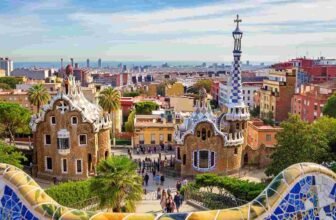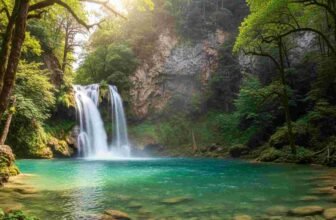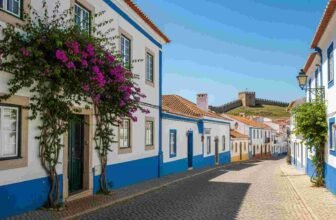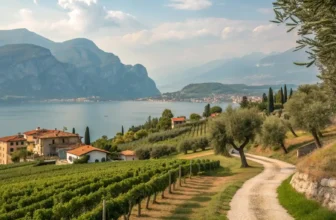
As the morning sun bathes the French countryside in hues of gold, a quiet magic stirs—a blend of history, art, and nature that invites exploration.
France is more than a destination; it’s a journey into wonder, where every cobblestone street and sweeping vista holds the power to inspire. In a world seeking connection and meaning, these experiences resonate deeper than ever, offering moments of discovery, awe, and reflection.
From hidden gems to iconic landmarks, the places ahead promise to enrich your soul and awaken your sense of adventure.
Let’s uncover the France of your dreams, one unforgettable step at a time.
1. Paris – Eiffel Tower & Louvre Museum

Paris, the heart of France, is a city of romance and timeless charm. Walking through its cobblestone streets, you’re enveloped in a symphony of art, culture, and history. The Eiffel Tower, shimmering against the night sky, feels like a surreal painting brought to life, while the Louvre, with its labyrinth of galleries, takes you on a journey through centuries of human creativity. As you sip coffee in a quaint Montmartre café, the city’s ambiance captures your soul, whispering stories of love and revolution.
During my visit, I remember gazing up at the Eiffel Tower from Champ de Mars, struck by its grandeur. A leisurely afternoon exploring the Louvre’s treasures was equally unforgettable, with the Mona Lisa’s enigmatic smile leaving a lasting impression. The streets of Paris feel alive, whether you’re wandering along the Seine or discovering hidden gems in Le Marais.
Practical Information
- Peak/Off-peak seasons: Spring (April-June) and fall (September-October) offer mild weather and fewer crowds. Winters are cozy but brisk, while summers can be bustling.
- Reaching & exploring: Paris is easily accessible via Charles de Gaulle or Orly airports. The metro is the most efficient way to navigate the city.
- Ideal duration: 3-5 days to cover highlights with leisure.
- Must-try local experiences: Sunset cruises on the Seine, crepes at a street-side stand, and a show at the Moulin Rouge.
- Budget considerations: Mid-range travelers can manage with €150-200/day. Luxury experiences may require more.
- Cultural etiquette tips: Always greet with “Bonjour” or “Bonsoir.” Respect quiet in public spaces like metro cars.
- Photography opportunities: The Eiffel Tower at dusk, the Louvre pyramid lit at night, and the colorful streets of Montmartre.
2. Provence – Lavender Fields & Hilltop Villages

Provence is a sensory feast, where fragrant lavender fields stretch endlessly, and medieval hilltop villages perch like jewels on rugged cliffs. Sun-drenched landscapes dotted with olive groves and vineyards paint a picture of rural bliss. Here, life slows down, and the rhythm of cicadas becomes your companion.
One golden evening, I strolled through the lavender fields near Sénanque Abbey, the sunset casting a dreamy glow. A visit to Gordes, one of Provence’s most stunning villages, left me in awe of its architectural harmony with the landscape. It’s a place that stirs something ancient and profound in the soul.
Practical Information
- Peak/Off-peak seasons: Lavender blooms in late June to mid-July. Spring and fall bring pleasant weather, while winter is serene but quieter.
- Reaching & exploring: Fly to Marseille-Provence Airport or take the TGV to Avignon. A rental car is ideal for exploring.
- Ideal duration: 4-6 days for a leisurely tour of key areas.
- Must-try local experiences: Wine tastings, Provençal markets, and cycling through vineyards.
- Budget considerations: Expect to spend €100-150/day; local markets are great for budget-friendly meals.
- Cultural etiquette tips: Greet vendors warmly at markets; they value personal interaction.
- Photography opportunities: Lavender fields at sunrise, stone villages like Roussillon, and pastel sunsets over vineyards.
3. French Riviera (Côte d’Azur) – Nice & Monaco

The French Riviera exudes glamour and Mediterranean allure. The azure waters shimmer under the sun, and the promenade-lined beaches of Nice are a haven for sunseekers. Monaco, with its grandeur and sophistication, invites you to a world of luxury, while quaint coastal towns like Èze enchant with old-world charm.
I fondly recall wandering through the flower market in Nice, its vibrant stalls reflecting the Riviera’s lively spirit. Another standout memory was standing at Monaco’s harbor, watching yachts glisten against the turquoise backdrop. Every corner of this region feels like a postcard come to life.
Practical Information
- Peak/Off-peak seasons: Summer (June-August) is lively but crowded; spring and fall are ideal for fewer crowds and mild weather.
- Reaching & exploring: Fly into Nice Côte d’Azur Airport or arrive by train. Public buses connect coastal towns, but a car offers flexibility.
- Ideal duration: 4-5 days to savor the highlights.
- Must-try local experiences: Stroll the Promenade des Anglais, visit the Oceanographic Museum in Monaco, and explore Èze’s medieval streets.
- Budget considerations: €150-250/day for mid-range stays; luxury options abound.
- Cultural etiquette tips: Dress stylishly, especially in Monaco. Casual beachwear is for beaches only.
- Photography opportunities: Coastal panoramas from Èze, sunset shots in Nice, and Monaco’s glittering skyline.
4. Mont Saint-Michel – Island Abbey

Mont Saint-Michel rises like a fairytale fortress from the sea, its spire crowned by the golden archangel. The journey to this iconic site feels like stepping into another era, where tides dictate access and ancient walls echo with history. Its abbey, perched high above, offers breathtaking views of the bay.
On my visit, I stayed until dusk, watching the island glow under soft lighting. Walking its narrow lanes, I felt the whispers of pilgrims who once made the arduous journey here. It’s a place where time slows, and wonder takes over.
Practical Information
- Peak/Off-peak seasons: Spring and fall are perfect for avoiding summer crowds. Check tide schedules for optimal visits.
- Reaching & exploring: Drive or take a train to Pontorson, then a shuttle to the island. Walking across the causeway is a unique experience.
- Ideal duration: 1-2 days to explore thoroughly.
- Must-try local experiences: Guided bay walks during low tide, exploring the abbey, and tasting the famed Mont Saint-Michel omelette.
- Budget considerations: A day trip costs ~€100, including meals and transport. Overnight stays offer a magical experience but are pricier.
- Cultural etiquette tips: Respect quiet zones in the abbey; dress modestly.
- Photography opportunities: Golden hour shots of the island, sweeping bay vistas, and atmospheric alleyways.
5. Loire Valley – Castles & Vineyards

The Loire Valley is a land of fairy-tale castles and rolling vineyards. Each château tells a story of opulence and intrigue, from the Renaissance grandeur of Château de Chambord to the romantic beauty of Château de Chenonceau. The valley’s vineyards yield some of France’s finest wines, perfect for sipping under the soft Loire sun.
A highlight was cycling between castles, the gentle breeze carrying the scent of blooming flowers. Sitting by the River Loire with a glass of local Sauvignon Blanc remains one of my most serene travel moments.
Practical Information
- Peak/Off-peak seasons: Spring and summer showcase lush gardens, while fall offers vibrant foliage. Winters are quieter but atmospheric.
- Reaching & exploring: Accessible via train to Tours or Orléans; cycling or driving is best for exploring.
- Ideal duration: 3-5 days to visit key castles and vineyards.
- Must-try local experiences: Wine tastings, hot air balloon rides, and garden tours at Villandry.
- Budget considerations: €120-180/day, with many affordable dining and accommodation options.
- Cultural etiquette tips: Be respectful in historic sites; engage warmly with vineyard hosts.
- Photography opportunities: Castles framed by gardens, river reflections at sunset, and vineyard vistas.
6. Bordeaux – Wine Country

Bordeaux is more than just a wine lover’s paradise—it’s a living testament to France’s mastery of elegance and flavor. Beyond the celebrated vineyards, the city itself hums with a vibrant mix of history and modernity. The striking Water Mirror (Miroir d’Eau) reflects the grandeur of Place de la Bourse, while the narrow streets of the Saint-Pierre district offer a taste of old-world charm.
Imagine a crisp autumn day, biking through the Médoc region, golden leaves falling as you pause to sample a bold Cabernet Sauvignon. Or picture a cool evening in the city, savoring local oysters paired with a glass of crisp white wine on the banks of the Garonne River—a quintessential Bordeaux moment.
Practical Information
- Hidden highlights: Visit lesser-known vineyards like Château La Dominique for its rooftop views or explore La Cité du Vin for an interactive wine journey.
- Unique scenarios: Attend a harvest festival in September or embark on a wine-blending workshop to create your own vintage.
- Travel tips: Reach Bordeaux by TGV from Paris in just over two hours. A mix of trams and bikes makes city exploration a breeze.
- Ideal trip style: Pair a weekend in the city with day trips to nearby wine regions.
- Don’t miss: Try Canelés, the caramelized pastry unique to Bordeaux.
- Photography tip: Capture reflections at the Water Mirror at dusk for stunning photos.
7. Alsace – Colmar & Strasbourg

Alsace feels like stepping into a fairy tale, where half-timbered houses in pastel hues line the canals. While Strasbourg charms with its cosmopolitan blend of French and German influences, Colmar offers an intimate, almost whimsical experience with its “Little Venice” district.
Winter transforms Alsace into a wonderland, with its Christmas markets rivaling those of Germany. Sipping mulled wine under twinkling lights in Strasbourg’s Place Kléber is as magical as it gets. And in spring, the rolling vineyards come alive, inviting visitors to explore the Alsace Wine Route, dotted with picturesque villages like Riquewihr.
Practical Information
- Seasonal appeal: Visit in December for festive markets or in May for lush vineyards. Summer can be busy but vibrant.
- Transportation: Strasbourg is well-connected by train. Rent a car or bike to explore the smaller towns.
- Special activities: A guided boat tour along the canals of Colmar or a visit to the Strasbourg Cathedral for its astronomical clock.
- Regional flavors: Indulge in tarte flambée and Alsace Rieslings.
- Cultural tip: Be prepared for bilingual signage (French and German) and embrace the fusion of cuisines.
- Photography tip: Snap the half-timbered houses in Colmar reflected in the canals at dawn.
8. Chamonix-Mont-Blanc – Alpine Adventure

Chamonix is the playground of adventurers and dreamers, nestled at the base of Europe’s tallest peak, Mont Blanc. While its reputation as a skiing destination is world-renowned, the town offers year-round thrills, from paragliding over jagged peaks to serene hikes through alpine meadows.
Picture yourself sipping hot chocolate in a cozy chalet after conquering the Aiguille du Midi cable car, which takes you to dizzying heights with unparalleled views. In summer, the rugged trails of the Tour du Mont Blanc loop are perfect for trekkers seeking solitude and scenery.
Practical Information
- Best seasons: Winter (December-February) for snow sports, or summer (June-September) for hiking and climbing.
- Getting there: The nearest airport is Geneva, with shuttle buses running regularly to Chamonix.
- Stay duration: 3-4 days, depending on activities.
- Insider experiences: Nighttime stargazing tours and visiting ice caves at the Mer de Glace glacier.
- Budget tip: Consider off-peak stays in late spring or early fall for lower accommodation rates.
- Photography tip: Capture the snow-capped Mont Blanc at sunrise for stunning contrast.
9. Dordogne Valley – Prehistoric Caves & Châteaux

The Dordogne Valley whispers secrets of ancient humanity and medieval might. While its stunning châteaux, like Château de Beynac, draw visitors, the real treasures lie underground in the prehistoric caves of Lascaux, where Stone Age art comes alive in vivid detail.
Picture paddling down the Dordogne River in a canoe, passing cliffside villages like La Roque-Gageac. Each bend in the river reveals new marvels, from fortresses perched high above to lush green valleys teeming with life.
Practical Information
- Hidden gems: Explore the lesser-known Font-de-Gaume caves, which feature original prehistoric art.
- Transportation tips: A car is essential for reaching remote attractions. Combine scenic drives with river excursions.
- Suggested timeline: 3-5 days to cover both natural and historical wonders.
- Must-try foods: Walnut cake and duck confit, both regional specialties.
- Unique cultural experience: Attend a medieval reenactment at one of the castles.
- Photography tip: Capture reflections of châteaux in the Dordogne River at sunrise.
10. Lyon – Gastronomy & Old Town

Lyon is where France’s culinary heart beats strongest. Known as the “Gastronomic Capital of the World,” this vibrant city entices food lovers with bouchons—traditional restaurants serving hearty Lyonnaise cuisine. Beyond the plate, Lyon’s Renaissance Old Town (Vieux Lyon) is a UNESCO World Heritage Site waiting to be explored.
Imagine wandering traboules, the city’s secret passageways, used by silk weavers and resistance fighters alike. As the golden hour sets in, the view from Fourvière Basilica unveils a panorama of terracotta rooftops and the Rhône River winding through.
Practical Information
- Best time to visit: Fall (September-November) brings harvest festivals, while December features Lyon’s iconic Festival of Lights.
- Getting there: Lyon is just two hours from Paris by TGV. The city is walkable, but its metro is efficient for longer distances.
- Stay duration: A weekend suffices for highlights, but 4-5 days allows culinary deep dives.
- Foodie musts: Try quenelles and praline tarts, then visit Les Halles de Lyon Paul Bocuse for gourmet delights.
- Cultural insight: Expect long, leisurely meals—food is an art form here.
- Photography tip: Nighttime illuminations along the Saône River and street views from Croix-Rousse.
11. Brittany – Coastal Villages & Carnac Stones

Brittany is a world apart, where rugged cliffs meet the Atlantic’s untamed waves, and ancient stone formations whisper secrets of a time long gone. The region’s coastal villages, like the fishing port of Saint-Malo, offer a tranquil yet vibrant escape, while the mysterious Carnac Stones rival Stonehenge in intrigue and scale.
Strolling the cobbled streets of Dinan, I stumbled upon a hidden crêperie tucked beneath ivy-covered walls, serving galettes paired with local cider. Along Brittany’s Pink Granite Coast, the interplay of light and rock formations created a surreal, almost otherworldly landscape—a scene that stayed with me long after I left.
Practical Information
- Hidden gem: The Ploumanac’h Lighthouse on the Pink Granite Coast, especially during golden hour, offers breathtaking views.
- Insider tip: Visit the Carnac Stones early in the morning for a quiet, mystical experience free from crowds.
- Seasonal highlights: Summer for vibrant coastal life, or autumn for peaceful walks along windswept beaches.
- Unique connection: Brittany’s Celtic heritage links it to Ireland and Wales, with festivals celebrating shared traditions.
- Sustainable travel: Explore by bike along Brittany’s extensive coastal paths to reduce your carbon footprint.
- Broader theme: Brittany reminds travelers that history and nature can coexist harmoniously, inspiring a slower, reflective travel style.
12. Normandy – D-Day Beaches & Rouen Cathedral

Normandy blends poignant history with timeless beauty. The D-Day beaches serve as solemn reminders of courage and sacrifice, while the charming town of Rouen, with its Gothic cathedral immortalized by Monet, celebrates France’s artistic and architectural heritage.
I remember standing on Omaha Beach at sunrise, the soft light illuminating the shore, transforming it into a place of quiet reverence. Later, wandering Rouen’s medieval streets, I stumbled upon an antique bookshop where stories of Joan of Arc came alive, offering a personal connection to the past.
Practical Information
- Unexpected find: Étretat’s dramatic white cliffs and natural arches, perfect for a day trip.
- Insider experience: Take a guided tour of the D-Day landing sites to gain deeper historical insight.
- Cultural connection: Normandy is the birthplace of Impressionism; visit the Museum of Impressionism in Giverny.
- Seasonal timing: Spring for blooming landscapes or June for D-Day anniversary events.
- Family-friendly travel: The interactive Caen Memorial Museum is an engaging way to teach kids about history.
- Broader theme: Normandy shows how travel can honor the past while celebrating the present.
13. Marseille – Mediterranean Port City

Marseille’s vibrant energy pulses with the rhythms of the Mediterranean. This port city is a melting pot of cultures, where markets hum with life, and street art tells stories of resilience and creativity. Beyond the city, the Calanques National Park offers dramatic fjord-like inlets perfect for nature enthusiasts.
Exploring the bustling Noailles Market, I sampled fresh olives and fragrant spices, feeling immersed in the city’s multicultural soul. Later, kayaking along the turquoise waters of the Calanques, I discovered hidden coves that felt like private paradises.
Practical Information
- Hidden highlight: Vallon des Auffes, a picturesque fishing harbor offering authentic local charm.
- Unique tip: Visit Le Panier, Marseille’s oldest district, for colorful street art and artisanal boutiques.
- Seasonal advice: Visit in spring or fall to enjoy pleasant weather and fewer crowds.
- Travel connection: Marseille’s ancient ties to trade and migration make it a living example of cultural exchange.
- Active travel: Hike the Calanques or take a boat tour to fully appreciate the area’s natural beauty.
- Broader theme: Marseille proves that the intersection of cultures can create something uniquely beautiful.
14. Champagne – Sparkling Wine Region

The Champagne region is synonymous with celebration and sophistication. Here, rolling vineyards stretch as far as the eye can see, while historic cellars beneath Reims and Épernay hold the secrets to crafting the world’s most famous sparkling wine.
During a private tour of a family-run vineyard, I learned the delicate art of sabrage—opening a Champagne bottle with a saber—a thrilling, unexpected experience. A quiet walk through the Avenue de Champagne at twilight, with its grand maisons lit softly, was pure magic.
Practical Information
- Hidden gem: Visit Hautvillers, the charming village where Dom Pérignon perfected Champagne.
- Travel tip: Stay in Épernay for easy access to vineyards and the Avenue de Champagne.
- Seasonal insight: Harvest season (September) offers a lively atmosphere, while winter brings cozy cellar tours.
- Cultural etiquette: Always toast before drinking Champagne—a tradition of gratitude and celebration.
- Luxury experience: Splurge on a Michelin-starred meal paired with vintage Champagne.
- Broader theme: Champagne invites travelers to savor life’s special moments.
15. Carcassonne – Medieval Walled City

Carcassonne feels like stepping into a storybook. Its perfectly preserved medieval walls and turreted towers dominate the skyline, transporting visitors back to the Middle Ages. Inside the citadel, cobblestone streets wind past artisan shops and cozy bistros.
On a moonlit evening, I joined a ghost tour through the castle’s ancient corridors, hearing tales of intrigue and mystery. By day, a quiet walk along the ramparts offered sweeping views of the surrounding countryside, a reminder of the fortress’s strategic importance.
Practical Information
- Hidden charm: Explore the lesser-known Bastide Saint-Louis, Carcassonne’s lower town, for a quieter vibe.
- Insider tip: Visit at sunrise or after sunset to experience the citadel without the crowds.
- Family activity: Kids will love exploring the castle’s dungeons and reenactments of medieval life.
- Seasonal timing: July hosts the Festival de Carcassonne, featuring music, theater, and fireworks.
- Budget-friendly: Consider staying in nearby towns for more affordable accommodations.
- Broader theme: Carcassonne reminds us of the timeless allure of storytelling and the enduring power of human ingenuity.






